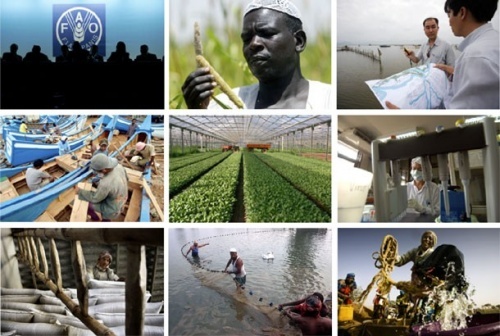
High and volatile agricultural commodity prices are likely to prevail for the rest of this year and into 2012 according to the latest analysis published today in FAO's biannual Food Outlook. The Report cites a sharp rundown on inventories and only modest overall production increases for the majority of crops as reasons for continuing strong prices.
The Report also cites speculation and the need for even greater transparency in futures market. In my opinion, the focus to address price spikes needs to be even more on discerning the impact of speculation and commodity driven yields, particularly questionably efficient biofuel crops. (Remainder of Article from FAO News Release & Report)
The next few months will be critical in determining how the major crops will fare this year, the report noted. Although prospects are encouraging in some countries such as the Russian Federation and Ukraine, weather conditions, featuring too little and in some cases too much rain, could hamper maize and wheat yields in Europe and North America.
"The general situation for agricultural crops and food commodities is tight with world prices at stubbornly high levels, posing a threat to many low-income food deficit countries," according to David Hallam, Director of FAO's Markets and Trade Division.
Slight drop in May food prices
International food prices, which earlier this year soared to levels seen in the 2007-8 food crisis, dropped a modest one percent in May. The FAO Food Price Index averaged 232 points in May from a revised estimate of 235 points in April but was still 37 percent above May 2010.
Declines in international prices of cereals and sugar were responsible for the slight decrease in the May index, more than offsetting increases in meat and dairy prices.
Current prospects for cereals in 2011 point to a record harvest of 2,315 million tonnes — a 3.5 percent increase over 2010, which marked a one percent drop over 2009.
Wheat
Global wheat output is expected to be 3.2 percent up from last year's reduced crop, mostly reflecting improved yields in the Russian Federation.
World production of coarse grains is set to climb 3.9 percent, exceeding the record set in 2008. Most of the increase is expected from the Russian Federation and the other members of the Commonwealth of Independent States (CIS).
Although preliminary, world paddy production prospects are for a record harvest of 463.8 million tonnes — a two percent increase over last year on expectations of improved weather conditions.
World cereals stocks at the close of the crop seasons in 2012 are put at 494 million tonnes, up only two percent from sharply reduced opening levels.
Export ban removal
Demand for cereals has also been increasing so that the 2011 crop, even at record levels, is expected to barely meet consumption, providing support to prices. But "the Russian Federation's announcement that it will remove its cereals export ban from July 2011 could help relieve some of that pressure," according to FAO's grain analyst, Abdolreza Abbassian.
In the oilseeds market, supplies in 2011/12 may not be sufficient to meet growing oil and meal demand, implying further reductions in global inventories.
By contrast, the global supply and demand balance for sugar points to some improvements, supported by large anticipated production in 2010/11, which is likely to surpass consumption for the first time since 2007/08.
Record meat prices
Regarding meat, high feed prices, disease outbreaks and depleted animal inventories were forecast to limit the expansion of global meat production to 294 million tonnes in 2011 — only one percent more than 2010. The international meat price index hit a new record at 183 points in May 2011 and a combination of strong import demand and limited export availability pointed to a further firming of prices in the next few months.
Following two consecutives years of low prices, fish markets have rebounded this year. Production in 2011 is heading to a record but prices are likely to be supported by strong demand from the developing countries.
Food import bill
In international food trade, the global food import bill is expected to reach a new record of $1.29 trillion in 2011 — 21 percent more than in 2010. Low-Income Food Deficit Countries (LIFDCs) and Least Developed Countries (LDCs) would be hardest-hit since they would likely have to spend respectively 27 and 30 percent more on food imports than last year.
Expenditures on imported foodstuffs for vulnerable countries could account for roughly 18 percent of their total import bills compared to a world average of around seven percent.
Futures market under scrutiny
The report highlights some of the differences in the way investors behaved in the price surge of 2010/11 versus 2007/08. Much has been done to improve market transparency but more is needed according to guest experts contributing to a Special Feature in Food Outlook.
More Related Reports at "International Financial Crisis" Channel -
diplomaticallyincorrect.org/c/international-financial-crisis
By Ambassador Muhamed Sacirbey
Facebook - Become a Fan at "Diplomatically Incorrect"
Twitter - Follow us at DiplomaticallyX

